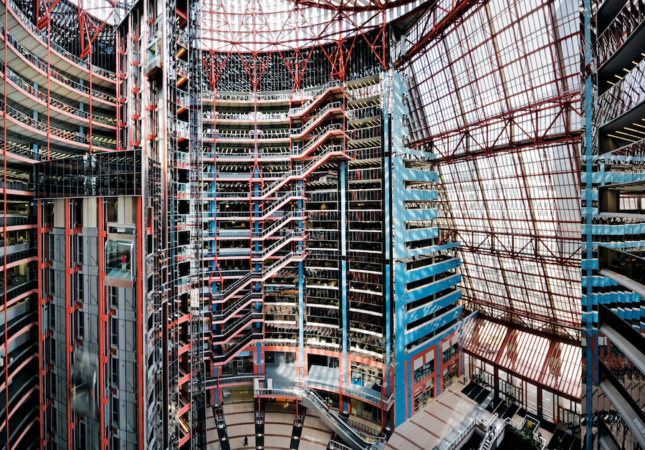If there ever was a time to slip away from reality for a moment to feast your eyes on buildings that are exaggerated, extravagant, eccentric, exuberantly colored, overly embellished, unabashedly hodgepodge-y, and incorporate cartoon dwarves as supporting columns, now is the time.
Postmodern Architecture: Less is a Bore, released late last month by Phaidon Press, is the perfect architectural tome for hunkering down with for an extended spell at home. Compiled and written by London-based curator and architectural historian Owen Hopkins, this is a photo-driven architectural survey that’s hefty in size, exhaustive in scope, and, most important, a lot of fun.
Featuring over 200 globe-spanning projects of all types and sizes, Postmodern Architecture—a more rambunctious companion piece to previous Phaidon surveys of modernism and brutalism—includes multiple works by the usual suspects: Michael Graves, Philip Johnson, Denise Scott Brown, Stanley Tigerman, Aldo Rossi, and, of course, Robert Venturi, the so-called father of postmodernism himself who coined the Mies-ribbing, anti-minimalist adage that the book borrows as its subtitle.
“It’s a celebration and a global survey,” Hopkins told AN of the book. “When creating a book like this there’s always the sense that you are establishing and promoting the canon. But at the same time, there’s an opportunity to broaden the canon, by including both the familiar projects and some unexpected stuff as well.”
To achieve this, Hopkins includes lesser-known practitioners of postmodern architecture; obscure and overlooked buildings; and in some cases, nonconformist structures that met the wrecking ball long ago. Also featured are works by architects who dabbled in postmodernism during the movement’s mid-1970s through late-1980s heyday but who are generally known for being more restrained in their approach. What’s more, Hopkins also included numerous examples of more contemporary postmodern architecture, as well as a sizable assortment of buildings that are playful, iconoclastic, and distinctly Dutch.

 The perfect quarantine companion: Postmodern Architecture: Less is A Bore is stuffed with over 200 weird, wonderful, and unorthodox buildings. (Courtesy Phaidon Press)
The perfect quarantine companion: Postmodern Architecture: Less is A Bore is stuffed with over 200 weird, wonderful, and unorthodox buildings. (Courtesy Phaidon Press)
Hopkins noted to AN that when curating Postmodern Architecture, he was “instinctively drawn to the classic buildings of that moment” like Arquitectonica’s Atlantis Condominium, a 1982 Miami luxury apartment tower that’s “so very redolent of that era.” A personal fan of the radically altered big-box showrooms designed by SITE for now-defunct American retailer Best Products, Hopkins was also “really interested and very eager to point out” the lesser-known work of the late, great postmodernist architect Charles Moore.
“Everyone knows the Piazza d’Italia, said Hopkins referring to Moore’s cheeky, column-heavy public plaza completed in downtown New Orleans in 1978. “But there’s much more to his work, and there’s a real kind of intellectual depth to it.” Hopkins pointed out Moore’s own home in Austin, Texas, as being “just this most extraordinary composition of ideas and forms and objects.”
In addition to big photos of bold buildings, Postmodern Architecture is also peppered with quotes from a range of architects, critics, and cultural figures—Andy Warhol, David Byrne, Charles Jencks, Noam Chomsky, Jane Jacobs, and Venturi to name just a few—who are either associated with postmodernism or “whose work has provided some kinds of inspiration or backdrop to the movement,” as the book’s preface explains. “These quotations provide both context or counterpoint. Some are rather more condemnatory than complimentary. Yet this is wholly fitting for a movement that revels in provocation and very often defines itself against a moribund status quo.”
“Postmodernism has been tainted with the brush of being a very kind of commercial architecture, and in many ways it is,” Hopkins told AN when asked why reactions—particularly contemporary reactions—to postmodern architecture are frequently disparaging. “And therefore it has been seen, partly at the time but particularly retrospectively, as kind of the embodiment of the worst aspects of 1980s individualism—so there’s that kind of more ideologically motivated prejudice against this moment.”
“Also, aesthetically, postmodern buildings, for the most part, are designed to stand out,” Hopkins continued. “They are often very bold in the forms that they employ and their colors, and in their decorative languages. And buildings that stand out do polarize opinion. At the same time, there’s lots of contextual, kind of polite postmodern architecture—but maybe not that much of it is in the book.”
“Maybe there’s a groundswell of architects who don’t like postmodernism,” Hopkins added. “But I think with the public, it’s always been popular.”
Below are eight projects featured in Postmodern Architecture—some quite iconic and others more under-the-radar—that run the gamut from private homes to public spaces to municipal office buildings and beyond. These are strictly North American projects, but there’s obviously a lot more where they came from.
Blue House, New Buffalo, Michigan; Margaret McCurry (1993)

 Blue House by Margaret McCurry, New Buffalo, Michigan. (©Conde Nast/Steve Hall of Hedrich Blessing/Courtesy Phaidon Press)
Blue House by Margaret McCurry, New Buffalo, Michigan. (©Conde Nast/Steve Hall of Hedrich Blessing/Courtesy Phaidon Press)
Best Products Showroom, Miami; James Wine/SITE (1979)

 Best Products Showroom by James Wines/SITE, Miami. (©James Wines/SITE/Courtesy Phaidon Press)
Best Products Showroom by James Wines/SITE, Miami. (©James Wines/SITE/Courtesy Phaidon Press)
Franklin Court, Philadelphia; Venturi Scott Brown and Associates (1976)

 Franklin Court by Venturi Scott Brown and Associates; Philadelphia. (©Venturi Scott Brown and Associates, Inc/Courtesy Phaidon Press)
Franklin Court by Venturi Scott Brown and Associates; Philadelphia. (©Venturi Scott Brown and Associates, Inc/Courtesy Phaidon Press)
James R. Thompson Center, Chicago; Helmut Jahn (1985)

 James R. Thompson Center by Helmut Jahn, Chicago (©Rainer Viertlböck/Courtesy Phaidon Press)
James R. Thompson Center by Helmut Jahn, Chicago (©Rainer Viertlböck/Courtesy Phaidon Press)
Academic Center at Georgia Gwinnett College, Lawrenceville, Georgia; John Portman Associates (2003)

 Academic Center at Georgia Gwinnett College by John Portman Associates, Lawrenceville, Georgia. (The Portman Archives/Courtesy Phaidon Press)
Academic Center at Georgia Gwinnett College by John Portman Associates, Lawrenceville, Georgia. (The Portman Archives/Courtesy Phaidon Press)
Casa Wolf, Ridgeway Colorado; Sottsass Associati (1989)

 Casa Wolf by Sottsass Associati, Ridgeway, Colorado. (©Santi Caleca/Sottsass Associates/Courtesy Phaidon Press)
Casa Wolf by Sottsass Associati, Ridgeway, Colorado. (©Santi Caleca/Sottsass Associates/Courtesy Phaidon Press)
Team Disney Building, Burbank, California; Michael Graves (1986)

 Team Disney Building by Michael Graves; Burbank, California. (Michael Graves Architecture & Design/Alamy Stock Photo/Courtesy Phaidon Press)
Team Disney Building by Michael Graves; Burbank, California. (Michael Graves Architecture & Design/Alamy Stock Photo/Courtesy Phaidon Press)
The Charles Moore House, Austin, Texas; Charles Moore

 The Moore House by Charles Moore, Austin, Texas. (The Charles Moore Foundation/Courtesy Phaidon Press)
The Moore House by Charles Moore, Austin, Texas. (The Charles Moore Foundation/Courtesy Phaidon Press)